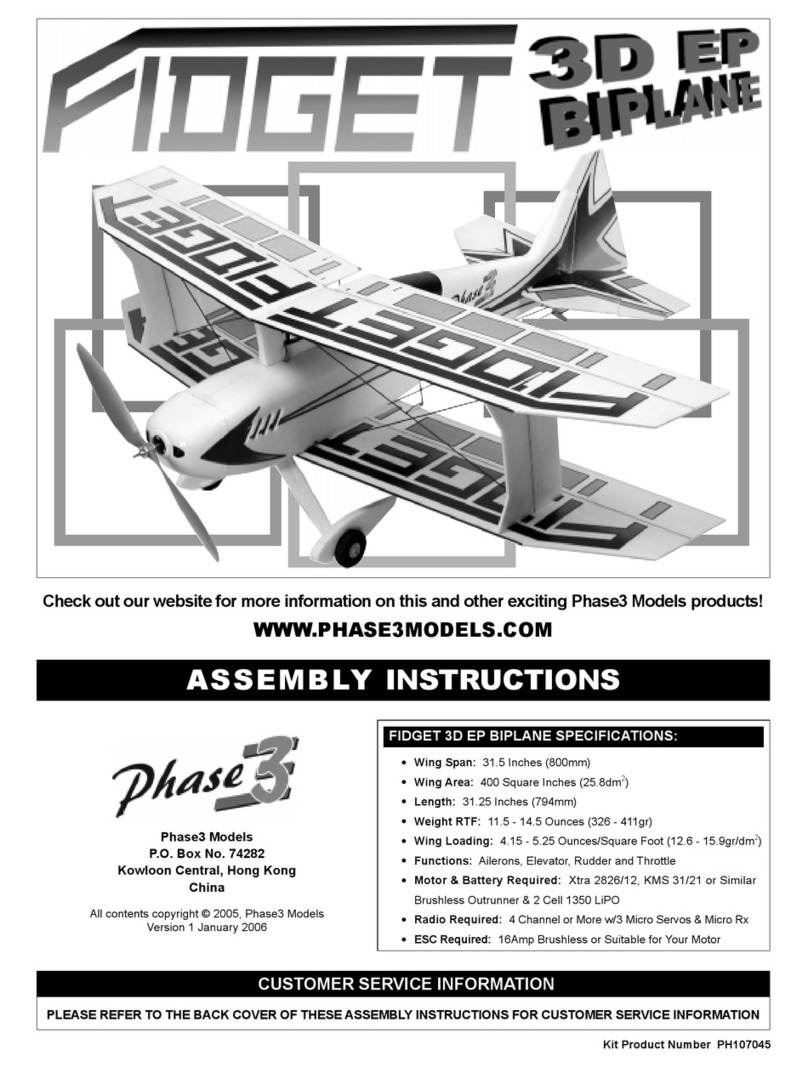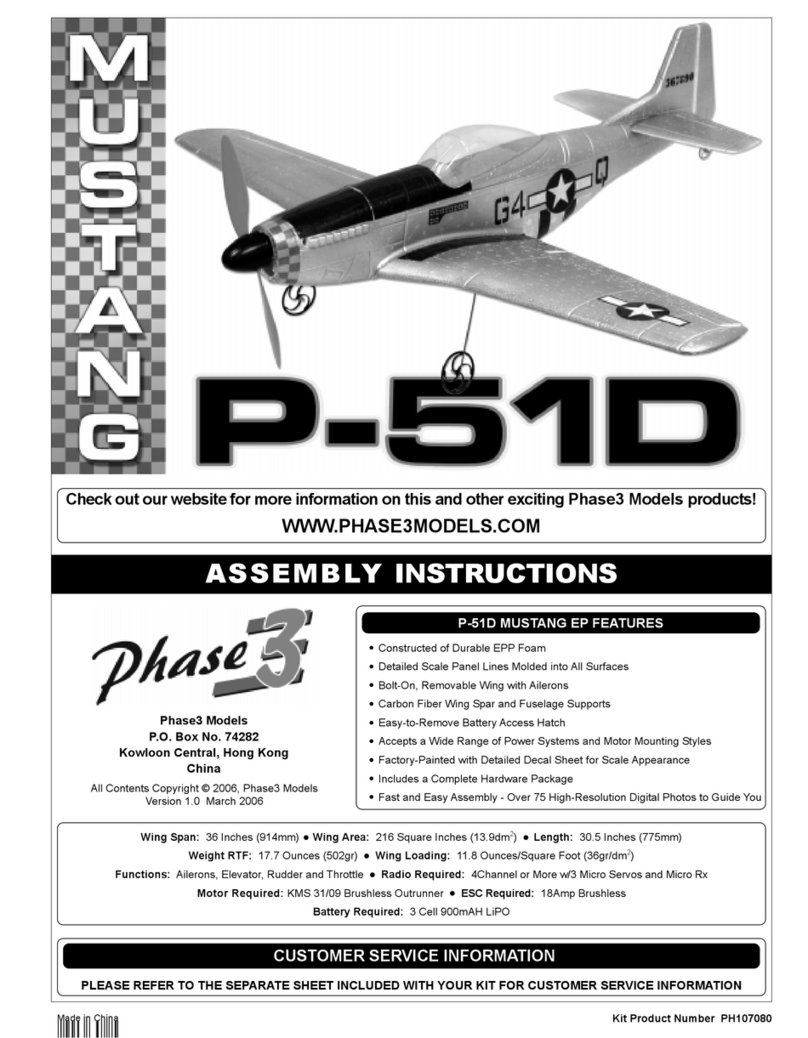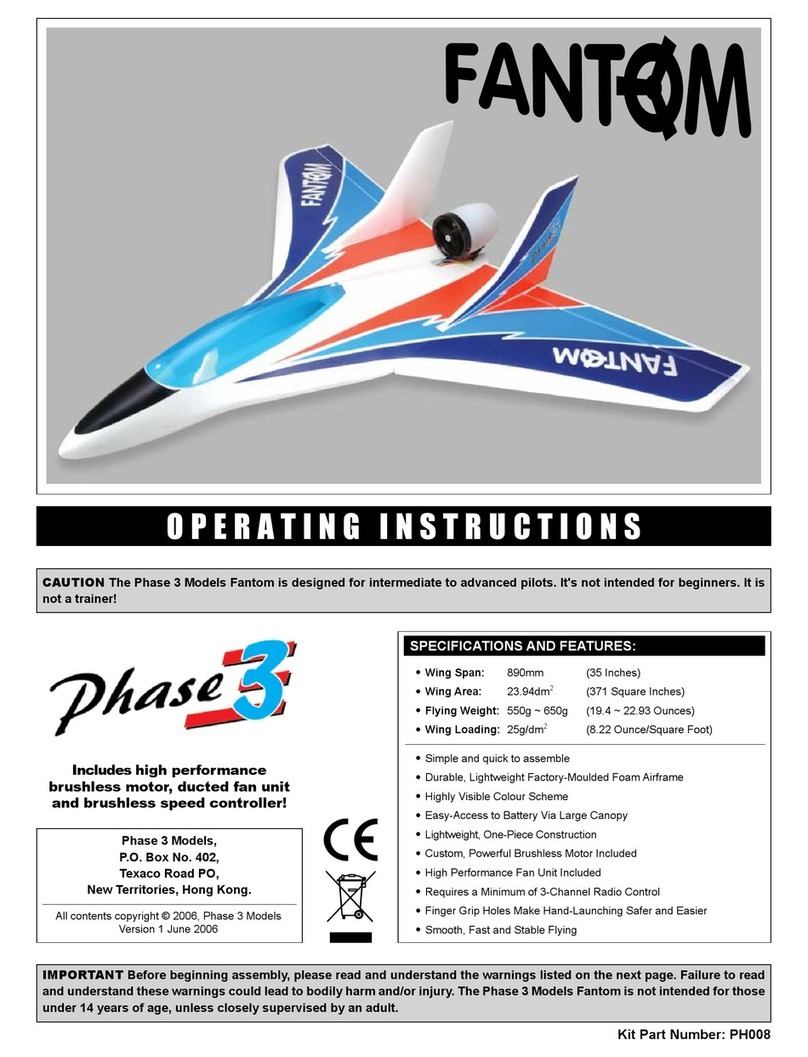
Page 2
Page 2
Page 2
TABLE OF CONTENTS
SAFETY WARNINGS
GENERAL WARNINGS
RADIO CONTROL SYSTEM WARNINGS
l Do not y your aircraft if another model is on the same frequency
as you. Before turning on your transmitter, make sure that there
are no other pilots ying on your frequency.
l Never y your aircraft from the street or at night. Always y in
an open area free of obstructions.
l When ying, make sure that any spectators are behind you.
lAlways be conscious of the spinning propeller. Be careful not
to allow loose clothing to be drawn into the propeller.
lBecause your aircraft is operated by radio control, it is important
to make sure you are always using fresh and/or fully charged
batteries (if using NiCD or NiMH batteries in your transmitter).
Never allow the batteries to run low or you could lose control of
the aircraft.
l Never attempt to disassemble any of the aircraft's components,
especially the servos, the ESC, and the Li-Po battery.
lDo not allow any of the components to get wet or electrical
damage may occur.
lAlways turn on your transmitter before plugging in the Li-Po
battery and always unplug the Li-Po battery before turning off
your transmitter.
lMake sure that your receiver antenna is fully extended or you
could lose control of the aircraft during ight.
l When ying the aircraft, make sure that your transmitter antenna
is completely extended.
lNever attempt to disassemble or modify any of the radio control
system components.
lYou should complete a successful range check of your radio
control system prior to each new day of ying, or prior to the
rst ight of a new or repaired aircraft.
lIf your aircraft gets dirty, do not use any solvents to clean it.
Solvents will damage the foam and plastic. Use a dry cloth to
clean any dirt from the outside of the aircraft.
LI-PO (LITHIUM POLYMER) BATTERY WARNINGS
lDO NOT leave the Li-Po battery unattended during the
charging process.
lALWAYS disconnect the Li-Po battery from the charger when
not in use.
lALWAYS place the Li-Po battery on a re-resistant surface during
the charging process and never charge the Li-Po battery near
any ammable material.
lALL instructions, warnings and cautions must be followed at
all times. Failure to do so can lead to serious injury or fire.
Instructions about charging the Li-Po battery can be found in
the Li-Po battery charging section.
lDO NOT use or charge the Li-Po battery if it's hot to the touch.
lDO NOT leave the Li-Po battery in direct sunlight or in a hot car
or storage area.
lDO NOT get the Li-Po battery wet or expose it to moisture.
lDO NOT short-circuit the Li-Po battery.
lDO NOT leave the Li-Po battery connected when not in use.
lDO NOT operate or charge the Li-Po battery unattended.
lALWAYS let the Li-Po battery cool between uses and charging.
lINSPECT the Li-Po battery before each use for swelling or
other malformation. If the Li-Po battery is damaged, it should
be discarded.
lWhen handling the Li-Po battery, do not poke, bend or damage it.
The Li-Po battery's outer casing is soft and can be damaged.
lDO NOT charge the Li-Po battery with reverse polarity.
lDO NOT overcharge. Maximum voltage for the Li-Po battery
must be followed.
lDO NOT over-discharge the Li-Po battery. NEVER discharge
below minimum volts.
lThe Li-Po battery must never exceed 160ºF (71ºC) for any
reason.
TRIMMING FOR LEVEL FLIGHT............................................................13
FIXING MINOR CRASH DAMAGE .........................................................14
TROUBLESHOOTING GUIDE................................................................ 15
WARRANTY INFORMATION .............................................. BACK COVER
SAFETY WARNINGS ...............................................................................2
INTRODUCTION....................................................................................... 3
TOOLS AND ACCESSORIES REQUIRED FOR FLIGHT......................... 3
PARTS IDENTIFICATION..........................................................................3
BECOMING FAMILIAR WITH YOUR P-40 WARHAWK EP RR................ 4
ASSEMBLING YOUR P-40 WARHAWK EP RR ....................................... 5
LEARNING TO FLY YOUR P-40 WARHAWK EP RR ............................... 9
YOUR FIRST FLIGHT .............................................................................12

































